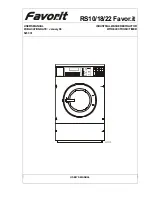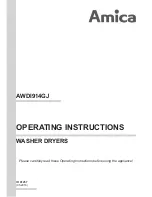
32
/ EN
Washing Machine / User’s Manual
– (*) in addition, there is siphon piece in the softener
compartment.
1
3
2
Detergent, softener and other cleaning agents
• Add detergent and softener before starting the washing
programme.
• Never leave the detergent drawer open while the washing
programme is running!
• When using a programme without prewash, do not
put any detergent into the prewash compartment
(compartment nr. "1").
• In a programme with prewash, do not put liquid detergent
into the prewash compartment (compartment nr. "1").
• Do not select a programme with prewash if you are using
a detergent bag or dispensing ball. Place the detergent
bag or the dispensing ball directly among the laundry in
the machine.
• If you are using liquid detergent, do not forget to place
the liquid detergent cup into the main wash compartment
(compartment nr. "2").
Choosing the detergent type
The type of detergent to be used depends on the type and
colour of the fabric.
• Use different detergents for coloured and white laundry.
• Wash your delicate clothes only with special detergents
(liquid detergent, wool shampoo, etc.) used solely for
delicate clothes.
• When washing dark coloured clothes and quilts, it is
recommended to use liquid detergent.
• Wash woolens with special detergent made specifically
for woolens.
A
warning
:
Use only detergents manufactured specifically
for washing machines.
warning
:
Do not use Powdered Soap.
Adjusting detergent amount
The amount of washing detergent to be used depends
on the amount of laundry, the degree of soiling and water
hardness.
• Do not use amounts exceeding the dosage quantities
recommended on the detergent package to avoid
problems of excessive foam, poor rinsing, financial
savings and finally, environmental protection.
• Use lesser detergent for small amounts or lightly soiled
clothes.
Using softeners
Pour the softener into the softener compartment of the
detergent drawer.
• Do not exceed the (>max<) level marking in the softener
compartment.
• If the softener has lost its fluidity, dilute it with water
before putting it in the detergent drawer.
Using liquid detergents
If the product contains a liquid detergent cup:
• Make sure that you have placed the liquid detergent cup
in compartment nr. "2".
• If the liquid detergent has lost its fluidity, dilute it with
water before putting in the detergent cup.
If the product does not contain a liquid detergent
cup:
• Do not use liquid detergent for the prewash in a
programme with prewash.
• Liquid detergent stains your clothes when used with
Delayed Start function. If you are going to use the Delayed
Start function, do not use liquid detergent.
Using gel and tablet detergent
Apply the following instructions when using tablet, gel and
similar detergents.
• If the gel detergent thickness is fluidal and your machine
does not contain a special liquid detergent cup, put the
gel detergent into the main wash detergent compartment
during first water intake. If your machine contains a liquid
detergent cup, fill the detergent into this cup before
starting the programme.
• If the gel detergent thickness is not fluidal or in the shape
of capsule liquid tablet, put it directly into the drum before
washing.
• Put tablet detergents into the main wash compartment
(compartment nr. “2”) or directly into the drum before
washing.
C
Tablet detergents may leave residues in the detergent
compartment. If you encounter such a case, place the
tablet detergent between the laundry, close to the lower
part of the drum in future washings.
Use the tablet or gel detergent without selecting the
prewash function.
Using starch
• Add liquid starch, powder starch or the fabric dye into the
softener compartment.
• Do not use softener and starch together in a washing
cycle.
• Wipe the inside of the machine with a damp and clean
cloth after using starch.
Summary of Contents for WNF 6200N
Page 1: ...Washing Machine User manual WNF 6200N...
Page 2: ...HE 2...
Page 3: ...HE 3...
Page 4: ...HE 4...
Page 5: ...HE 5 1 1 1 8 3 A 16 1 2 1 3...
Page 6: ...HE 6 1 4 1 5 WEEE Directive 1 6 EU 2012 19 WEEE WEEE RoHS EU 2011 65 RoHS...
Page 8: ...HE 8 2 5 A 40 100 40 100cm 40cm 15 3 2 2 6 A 1 2 3 A 2 7 A 16 16 16 B 1 2 5 5 3 4 2 3 C A...
Page 9: ...HE 9 3 3 1 3 2 pilling 3 3 3 4 C C 3 5 A...
Page 11: ...HE 11 2 C C 50 2...
Page 12: ...HE 12 3 8 40 90 C 40 C 40 C 30 C Heavily Soiled Normally Soiled Lightly Soiled...
Page 13: ...HE 13 4 4 1 1 2 3 4 5 6 7 1 2 7 6 5 4 3 3 Eco 20 Mini Mini 14...
Page 15: ...HE 15 4 6 Pump Spin No Spin C 4 7 C 4 8 Rinse Hold No Spin C...
Page 17: ...HE 17 4 10 3 C C C C C 30 A 9 6 3 C 3 6 9 3 C 3...
Page 19: ...HE 19 C C C A 5 3 5 4 1 2 3 4 5 5 4 17 2 5 5 1 4 5 1 C 2 3 5 2 100 2 2...
Page 20: ...HE 20 3 A 1 A C 90 2 C 3 4 5 A 6...
Page 22: ...HE 22 7 A...
Page 23: ......
Page 24: ...WNF 7280 N...













































